Overview
The article addresses the critical challenge of integrating legacy systems, underscoring the necessity of strategic approaches for IT managers. It highlights essential strategies such as:
- Conducting comprehensive assessments
- Adopting phased integration
- Utilizing middleware solutions
- Engaging stakeholders early
These strategies collectively empower organizations to enhance operational efficiency and sustain competitiveness amid digital transformation. How can your organization leverage these best practices to navigate the complexities of integration? By embracing these methods, IT managers can not only streamline processes but also position their organizations for future success. Furthermore, adopting a structured approach ensures that all stakeholders are aligned, facilitating smoother transitions and minimizing disruptions. As a result, organizations can thrive in an increasingly digital landscape, ensuring they remain at the forefront of innovation.
Introduction
In an era marked by relentless technological advancements, organizations often find themselves constrained by legacy systems that, despite being outdated, are vital to their operations. These systems are the backbone of essential processes, especially in regulated sectors such as banking and healthcare, where compliance and security take precedence.
As businesses embark on their digital transformation journeys, the challenge of integrating these legacy systems with modern technologies becomes increasingly pressing. Understanding the complexities of this integration process is crucial for organizations striving to enhance efficiency, reduce costs, and ultimately excel in a competitive landscape.
This article explores the significance of legacy systems, the prevalent challenges encountered during integration, and best practices that can empower organizations to successfully navigate this intricate terrain.
Understanding Legacy Systems: Definition and Importance
Legacy technologies represent outdated computing frameworks, software applications, or tools that, despite their lack of modern capabilities, continue to play a vital role in business operations. These frameworks often serve as the foundation for essential processes, particularly in sectors like banking and healthcare, where adherence, dependability, and safety are paramount. As organizations embark on their digital transformation journeys, understanding the significance of these outdated platforms becomes crucial for developing effective strategies for integrating legacy systems.
Data from 2025 indicates that approximately 70% of banking organizations still rely on outdated frameworks, which can hinder innovation and adaptability to market demands. This reliance underscores the necessity for a strategic approach to legacy system integration that not only preserves the effectiveness of these networks but also enhances their compatibility with contemporary technologies. Avato’s hybrid integration platform is specifically designed to address these challenges, enabling organizations to enhance and extend the value of their existing infrastructures while simplifying complex integrations.
Furthermore, the platform provides real-time monitoring and alerts on performance, ensuring that organizations can respond swiftly to any issues that arise.
Expert opinions highlight that integrating legacy systems can establish a strong foundation for effective digital transformation. IT leaders emphasize that these platforms can be leveraged to uncover valuable data insights, boosting efficiency and refining decision-making processes. A need-focused strategy in healthcare, which actively identifies when to act, illustrates that integrating legacy systems with traditional frameworks can lead to improved patient outcomes and operational efficiency.
Practical examples further illustrate the successful integration of legacy systems within newer frameworks. In the banking sector, institutions that have embraced open banking regulations have experienced a notable increase in their common equity tier 1 capital, estimated at 9% for global systemically important banks. This shift not only enhances consumer protections but also demonstrates the capacity of traditional infrastructures to adapt to new business models.
Gustavo Estrada, a customer, remarked, “Avato has the ability to simplify complex projects and deliver results within desired time frames and budget constraints,” underscoring the effectiveness of integration strategies.
Case studies reveal that over 60 nations have adopted or are in the process of adopting open banking regulations, highlighting the essential role of traditional infrastructures in facilitating compliance and innovation. Additionally, there is a growing movement to replace outdated care delivery models with transformative approaches that prioritize value-based care and need-based healthcare delivery. As organizations navigate the complexities of digital transformation, the integration of legacy technologies remains a critical element in ensuring operational continuity and achieving strategic objectives, with Avato leading the way in providing the necessary tools and expertise to significantly reduce costs.
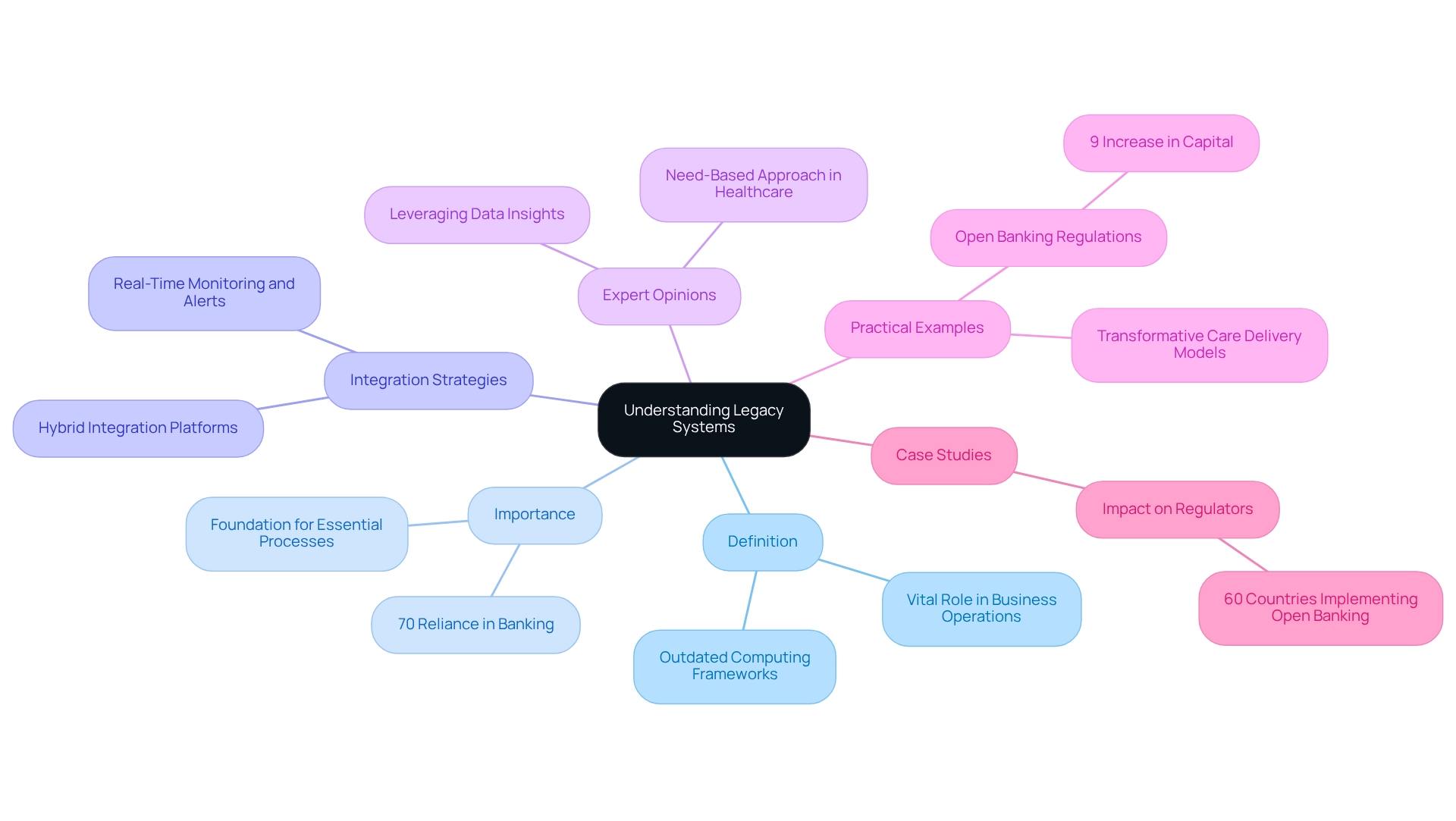
Common Challenges in Legacy System Integration
Integrating legacy systems presents several significant challenges that organizations must navigate:
- Data Incompatibility: Legacy systems frequently utilize outdated data formats, complicating the exchange of information with modern applications. This incompatibility can lead to delays in data processing and hinder the overall efficiency of operations, particularly during the integration of legacy systems. Statistics show that organizations frequently dedicate as much as 75% of their IT budgets to sustaining these obsolete infrastructures, highlighting the financial strain of such incompatibilities.
- Security Risks: Numerous outdated infrastructures lack strong protective measures, rendering them susceptible to possible breaches. As cyber threats develop, the risks associated with the integration of legacy systems into a more contemporary infrastructure can expose organizations to considerable security challenges. Avato’s hybrid unification platform is designed for secure transactions, ensuring that sensitive data stays safeguarded during unification processes, particularly in sectors like banking and healthcare.
- Limited Documentation: Inadequate documentation is a frequent problem with outdated platforms, complicating the merging process. Without clear guidelines or records, IT teams may struggle to understand functionalities, which can result in an increased integration of legacy systems and potential errors. Avato tackles this challenge by supplying tools that precisely depict the current condition and optimal condition of frameworks, facilitating smoother transitions.
- Resistance to Change: Employees who are accustomed to legacy systems may resist adopting new technologies. This resistance can significantly hinder the integration of legacy systems, as successful implementation often relies on user buy-in and training. Mobilizing stakeholders effectively is crucial, and Avato emphasizes the importance of engaging users early in the process to foster acceptance and ease the transition.
Expert insights emphasize that organizations striving for swift IT transformation should focus on initiatives that provide significant advantages with minimal disruption. For instance, migrating to a cloud-hosted email server is a common initial strategy that can yield quick wins. By concentrating on minor, achievable improvements, organizations can enhance confidence and enable the gradual integration of legacy systems, ultimately leading to a more successful digital transformation.
As noted by Tony Leblanc from the Provincial Health Services Authority, “Good team. Good people to work with. Extremely professional. Extremely knowledgeable,” emphasizing the value of partnering with experts like Avato.
Furthermore, a Deloitte survey indicated that 61% of organizations could attain savings by renegotiating agreements with current providers, further demonstrating the financial consequences of outdated infrastructure. The case study titled “Choosing Initiatives for Digital Transformation” indicates that organizations frequently seek swift traditional IT transformation but should concentrate on initiatives that offer substantial advantages with minimal disruption. By addressing these challenges, organizations can modernize their operations and enhance their competitive edge in 2025.
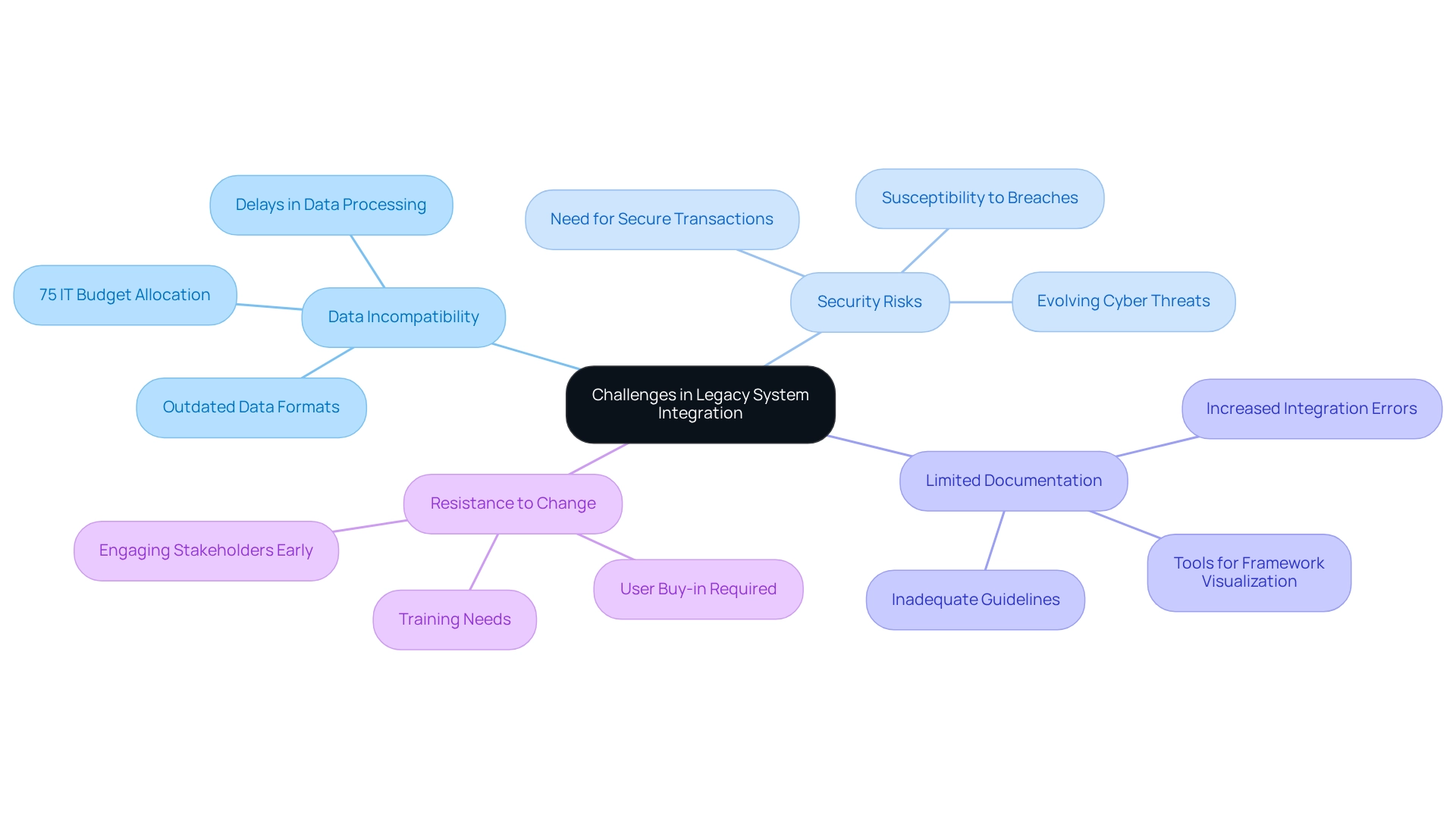
Benefits of Integrating Legacy Systems for Modern Operations
The integration of legacy systems presents a multitude of benefits that can significantly enhance organizational performance, particularly within the banking sector. Key advantages include:
-
Enhanced Operational Efficiency: The integration process streamlines operations, drastically reducing manual workloads and leading to improved productivity. Organizations that modernize their systems frequently observe an operational performance increase of up to 35%, especially when leveraging an enterprise service bus (ESB) for seamless data transfer. This shift allows teams to concentrate on strategic initiatives rather than routine tasks. Moreover, the incorporation of generative AI technologies has yielded a remarkable 60% rise in customer experience enhancements, particularly through advanced chatbots and virtual assistants, further boosting operational efficiency. For instance, AI-driven chat solutions enable banks to swiftly address customer inquiries, underscoring the practical advantages of these technologies.
-
Improved data access is another critical benefit of integrating legacy systems, facilitating enhanced visibility of data across departments, which in turn enables quicker and more informed decision-making. In environments where timely information is crucial for customer service and regulatory compliance, this enhanced access proves invaluable. Avato’s hybrid integration platform supports this by providing a connected foundation that simplifies and standardizes data access across various structures, as evidenced by case studies where clients achieved notable improvements in data retrieval times.
-
Cost Savings: By adopting current frameworks, organizations can avoid the substantial expenses associated with complete system overhauls. In fact, effective modernization strategies can reduce maintenance costs by as much as 50%, allowing funds to be redirected towards innovation and growth. Furthermore, the 2023 Cost of a Data Breach Report by IBM revealed that organizations experiencing higher costs and extended breach lifecycles are often those with outdated legacy systems, highlighting the necessity of modernizing these systems for enhanced security and cost-effectiveness. The company’s solutions are engineered for secure transactions, establishing them as a reliable choice for banks and financial institutions. A case study involving a major bank illustrated how the company’s unification solutions significantly lowered operational expenses while bolstering security measures.
-
Enhanced Agility: Updated infrastructures empower organizations to respond more swiftly to market fluctuations and evolving customer demands. This agility is vital in the competitive banking landscape, where the capacity to adapt can dictate success. The company’s expertise in hybrid unification enables financial organizations to balance speed with the complexity required to prepare their technology frameworks for the future. A recent collaboration with a healthcare partner demonstrated how these solutions facilitated rapid adjustments to new regulatory requirements, emphasizing the flexibility that modern frameworks can provide.
Real-world examples reinforce these benefits. For instance, the company has demonstrated how comprehensive support for network coordination can lead to operational efficiency and effectiveness in IT projects. Specifically, their services have enabled organizations to realize significant operational gains, highlighting the strategic value of such initiatives.
Moreover, insights from IT managers reveal that integrating older technologies not only enhances operations but also leads to substantial cost reductions. Gustavo Estrada noted, “Avato has simplified complex projects and produced outcomes within expected timelines and budget limitations,” which underscores the success of these integration efforts.
As organizations continue to navigate the complexities of digital transformation, the integration of legacy systems emerges as a crucial strategy for enhancing operational efficiency and maintaining a competitive edge.
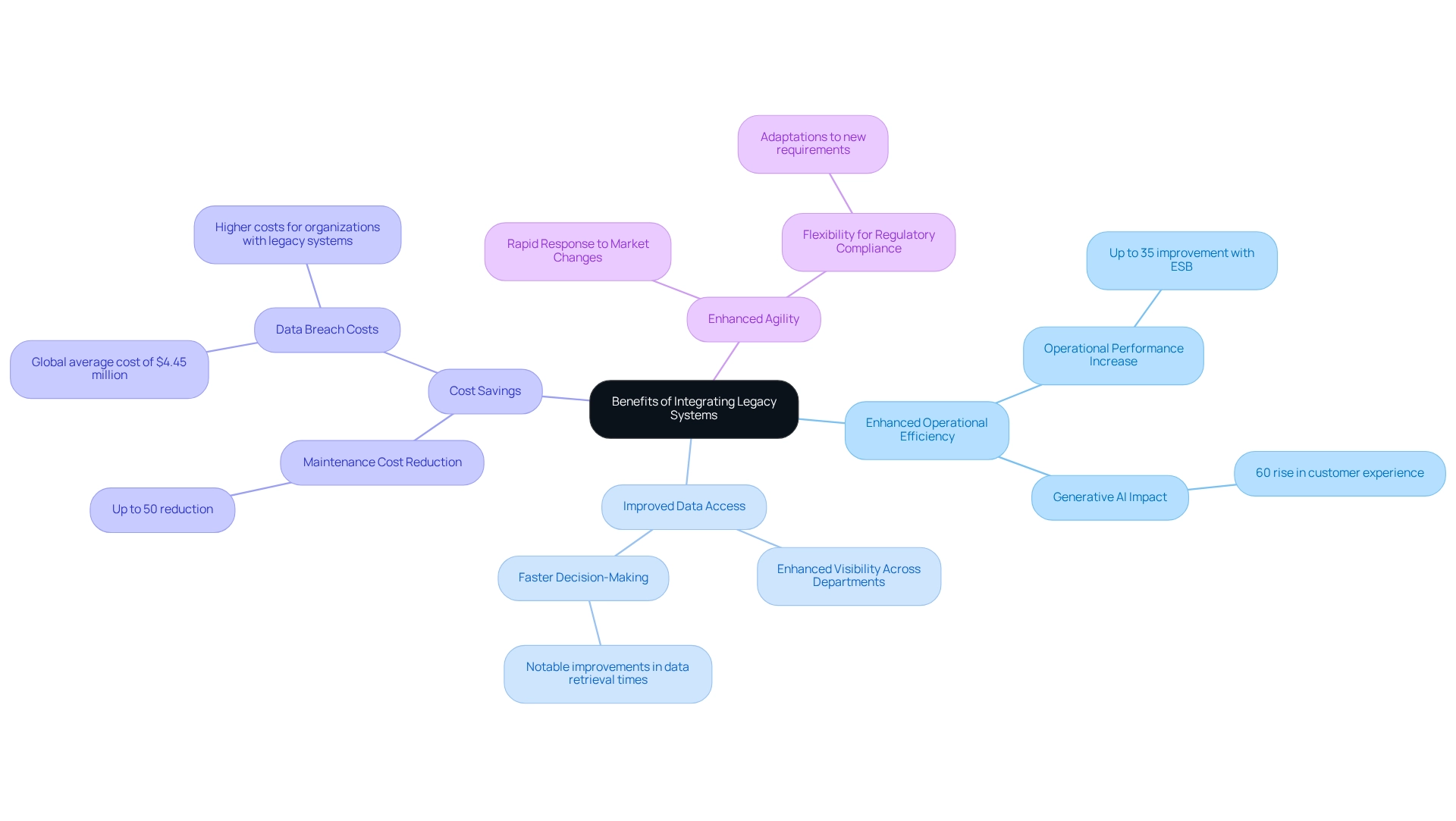
Best Practices for Successful Legacy System Integration
To ensure successful legacy system integration, it is imperative to consider the following best practices:
-
Conduct a Comprehensive Assessment: Begin by thoroughly evaluating existing systems to understand their architecture, dependencies, and integration requirements. This foundational step is crucial for identifying potential challenges and opportunities for improvement.
-
Adopt a Phased Approach: Implementing integration in stages can significantly reduce risks and allow for necessary adjustments based on real-time feedback. Research indicates that organizations utilizing a phased approach experience higher success rates, with agile methodologies leading to project costs that are 28% lower than traditional methods. This approach aligns well with Avato’s reliable, future-proof technology stack, which helps businesses adapt to changing demands.
-
Utilize Middleware Solutions: Middleware plays a vital role in facilitating communication between legacy and modern systems, ensuring seamless data flow. By utilizing these solutions, organizations can improve interoperability and simplify merging processes.
-
Engage Stakeholders Early: Involving key stakeholders throughout the unification process is essential for aligning goals and expectations. Early engagement fosters collaboration and ensures that all parties are invested in the project’s success. This is essential for enhancing coordination strategies with Avato, as it enables efficient process modeling and ensures the longevity of frameworks. Mobilizing stakeholders to accurately capture requirements is key to achieving a successful integration.
-
Invest in Training and Skill Development: As merging outdated and contemporary technologies often necessitates new skill sets, investing in training is essential. This not only prepares the workforce to manage and integrate new technologies effectively but also cultivates a culture of continuous learning, which is essential for keeping pace with technological advancements. For instance, the integration of legacy systems with modern systems requires new skill sets, and investing in training prepares the workforce to support modernization efforts.
-
Monitor and Measure Performance: Establish strong monitoring practices to track the performance of the system. Organizations that prioritize monitoring see up to a 30% increase in long-term data quality post-upgrade, underscoring the importance of ongoing assessment. Continuous monitoring and robust analytics capabilities are essential for optimizing operations, improving customer experiences, and identifying new opportunities for innovation. As Gustavo Estrada pointed out, “Avatar has the capability to streamline intricate projects and provide outcomes within intended timelines and financial limitations,” emphasizing the effectiveness of strong oversight in reaching unification objectives. Employing the appropriate technology and tools to demonstrate the current and ideal states is essential for successful implementation.
By adhering to these optimal practices, IT leaders can manage the challenges of older technology amalgamation more efficiently, ensuring that their organizations remain adaptable and competitive in a constantly changing environment.
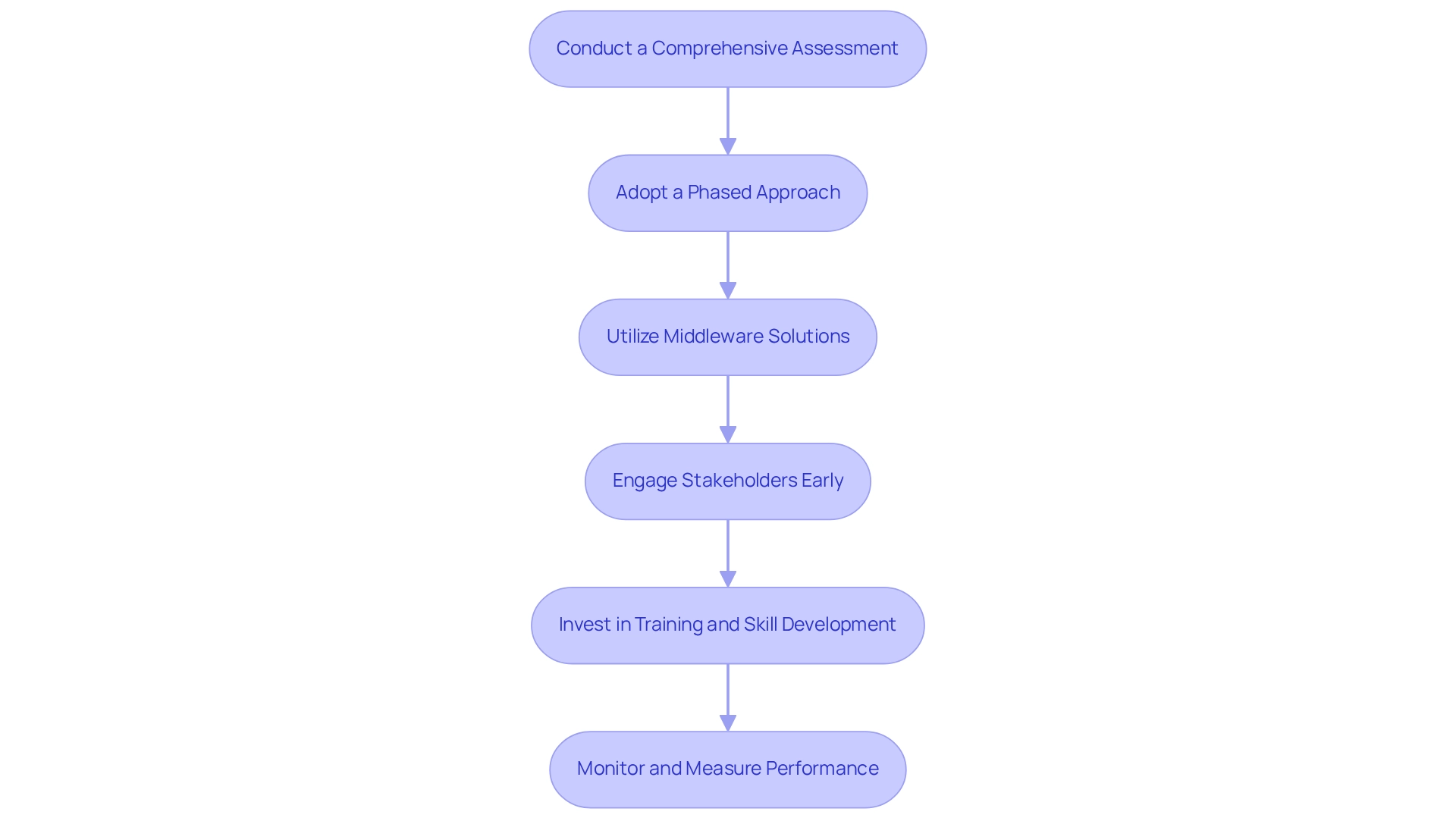
Assessing Legacy Systems: Key Considerations Before Integration
Before embarking on the amalgamation of outdated platforms, it is essential to evaluate several critical assessment elements that can significantly impact the success of the project:
-
Architecture: Conduct a thorough analysis of the current structure to identify connection points and recognize potential bottlenecks. Understanding the existing configuration is vital for crafting a seamless incorporation plan that minimizes disruptions.
-
Data Quality: Assess the quality of information within outdated frameworks, as this is crucial for ensuring accuracy and reliability post-integration. Poor data quality can lead to substantial issues, including operational inefficiencies and compliance risks. Statistics indicate that organizations often face data quality challenges in older platforms, which can hinder consolidation efforts.
-
Compliance Requirements: It is imperative to ensure that the consolidation plan adheres to industry regulations and standards, especially in sensitive sectors such as banking and healthcare. Non-compliance can result in significant penalties and reputational damage, making this a vital consideration.
-
User Impact: Evaluate how the integration will affect end-users. Understanding user needs and potential challenges is essential for planning effective training and support. Engaging users from the outset can facilitate smoother transitions and enhance overall satisfaction.
By addressing these elements, organizations can more effectively navigate the complexities involved in integrating legacy systems, ultimately leading to improved operational capabilities and reduced costs. This hybrid unification platform exemplifies this approach, serving as a robust solution to the challenges of integrating legacy systems and fragmented data. It empowers businesses to simplify complex projects and achieve desired outcomes efficiently.
The company is dedicated to designing the technological infrastructure necessary to enrich connected customer experiences, ensuring that collaborative efforts are not only efficient but also aligned with contemporary business requirements. As noted by Gustavo Estrada from BC Provincial Health Services Authority, the solution is lauded for its ability to simplify complex projects and deliver results within desired time frames and budget constraints. Furthermore, Avato guarantees 24/7 availability for critical connections, enhancing its reliability in the process.
The platform effectively addresses the challenges associated with integrating legacy systems, isolated outdated frameworks, and fragmented data, thereby enhancing operational capabilities and lowering expenses while fostering a culture of innovation through comprehensive staff training and change management strategies.
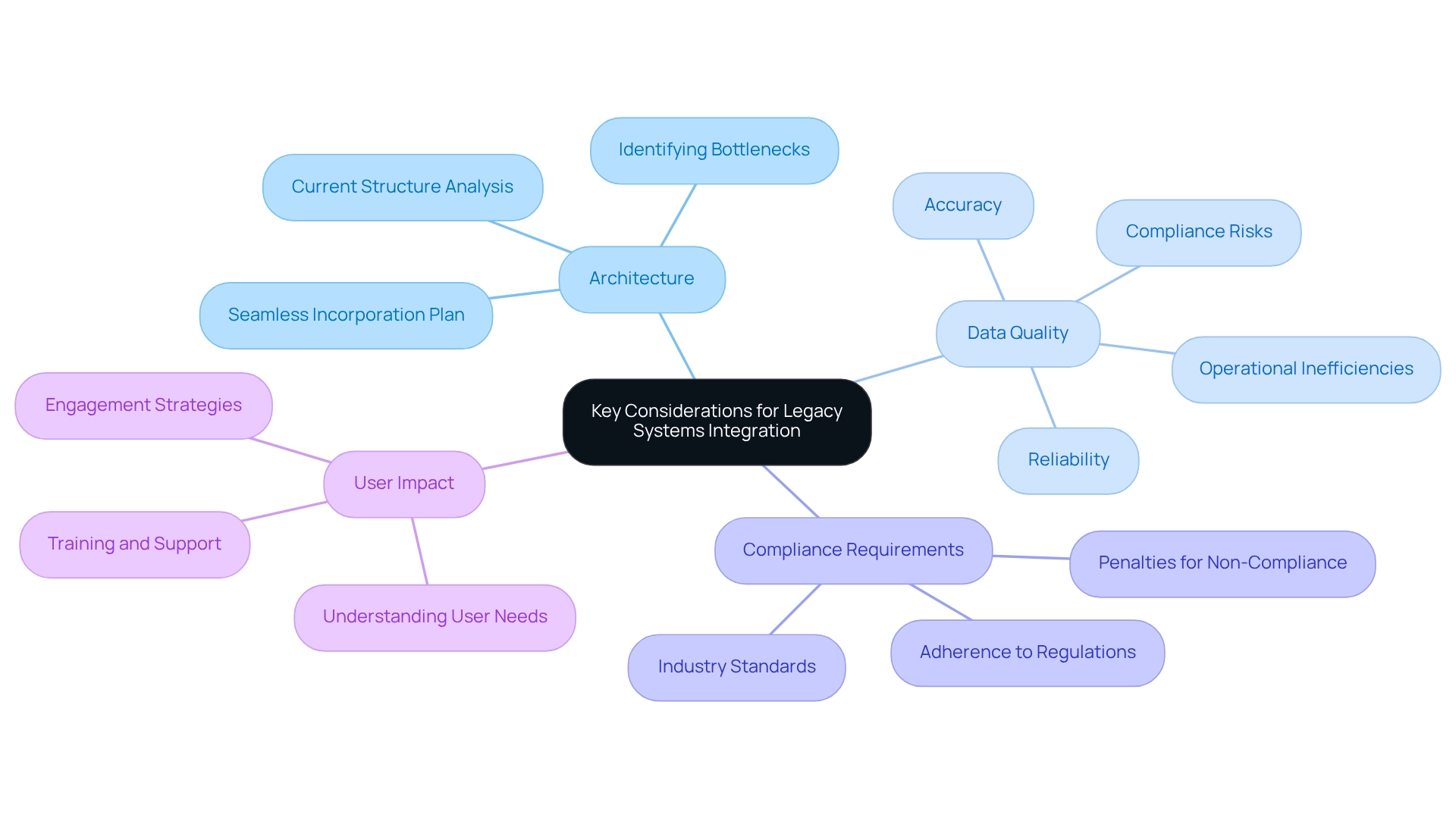
Tools and Technologies for Effective Legacy System Integration
The integration of legacy systems is crucial for organizations aiming to efficiently incorporate older platforms while modernizing their operations and ensuring seamless connectivity. Several tools and technologies play a pivotal role in facilitating this process:
- Enterprise Service Bus (ESB): ESBs act as the backbone for communication between disparate systems, enabling seamless data exchange and integration across various platforms. By centralizing communication, ESBs reduce complexity and enhance the reliability of data flows.
- Platform for Service Integration (iPaaS): iPaaS solutions, such as hybrid platforms, offer cloud-based connectivity features that simplify the link between legacy and contemporary applications. The adoption of these platforms is on the rise, with usage rates projected to increase significantly in 2025 as organizations seek to streamline the integration of legacy systems into their processes. These platforms include robust connectors and pre-designed templates that accelerate integration activities and reduce time-to-value.
- API Management Tools: These tools are essential for creating and managing APIs that expose legacy functionalities to modern applications. By enhancing interoperability, API management tools empower businesses to leverage existing infrastructures while integrating new technologies, a critical aspect of the platform. Avato also provides comprehensive API security features to ensure compliance with industry standards.
- Data Transformation Tools: Utilizing ETL (Extract, Transform, Load) tools guarantees data compatibility between legacy and modern systems. These tools facilitate the necessary changes to make data usable across various environments, thereby promoting efficient incorporation.
The adoption of these technologies, alongside the integration of legacy systems, not only boosts operational efficiency but also cultivates a culture of continuous improvement. For instance, investing in automated testing can enhance operational efficiency while fostering a culture of ongoing enhancement. Additionally, investing in compliance technologies can lead to a 25% reduction in the likelihood of data breaches, underscoring the importance of secure implementation practices.
The platform includes integrated compliance monitoring tools that assist organizations in adhering to regulatory requirements.
Avato ensures round-the-clock availability for essential connections, which is vital for organizations relying on seamless connectivity. Case studies demonstrate that following best practices for legacy modernization—such as recognizing strengths and weaknesses, ensuring compliance, and collaborating with impacted departments—facilitates a smooth transition to modernized technologies. This strategic approach, combined with real-time monitoring and performance notifications, enables organizations to achieve their unification objectives swiftly and effectively.
As noted by Gustavo Estrada, a client, “This platform simplifies complex projects and delivers outcomes within desired time frames and budget constraints,” emphasizing the effectiveness of the hybrid system in enabling successful connections and transforming financial institutions with speed and reliability.
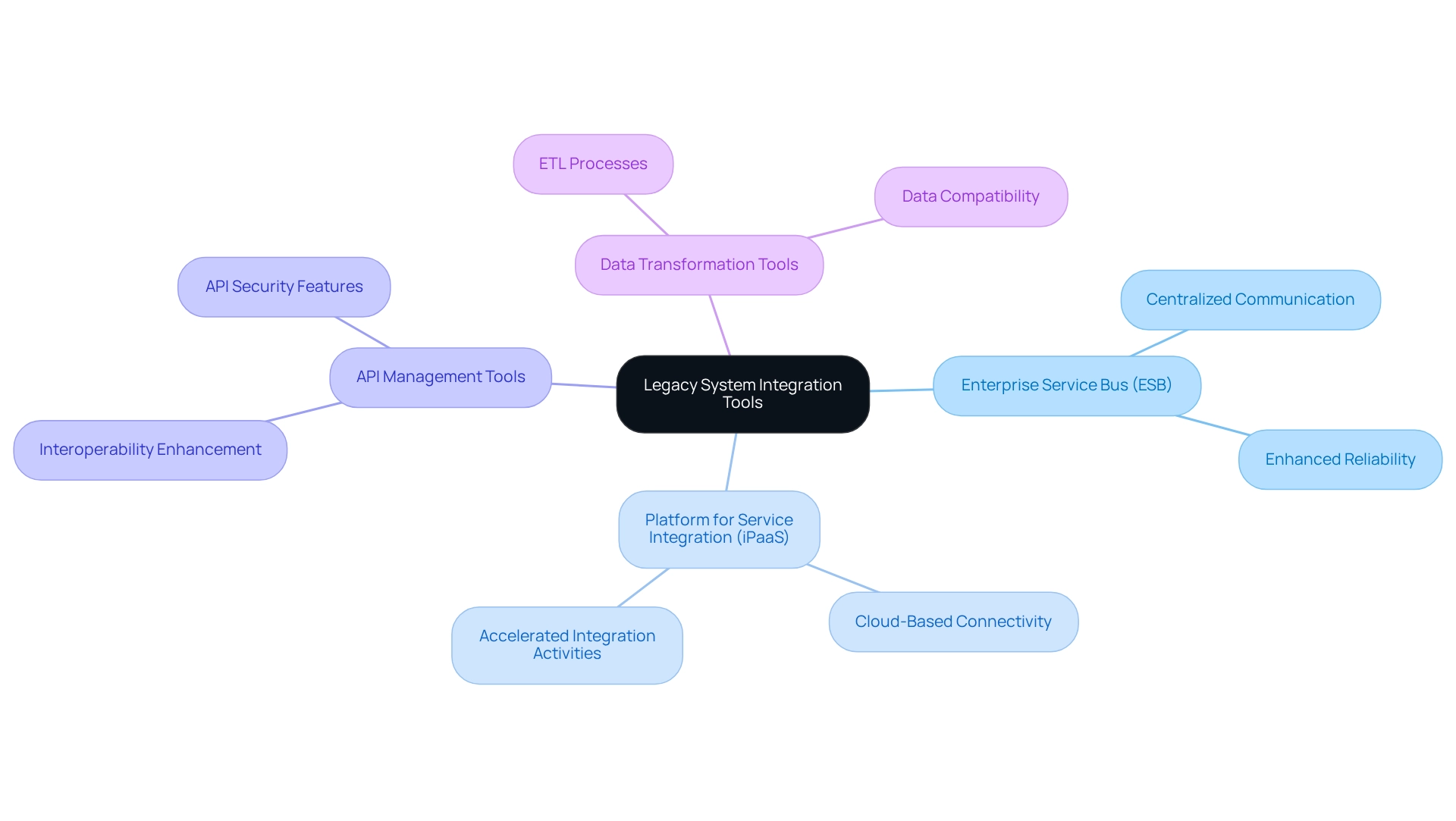
Ensuring Security and Compliance in Legacy System Integration
To ensure security and compliance during the integration of older platforms, it is essential to implement a series of robust measures, particularly with the support of a dedicated hybrid integration platform.
-
Implement Strong Authentication: Multi-factor authentication (MFA) is crucial for securing access to older platforms. By requiring multiple forms of verification, organizations can significantly reduce the risk of unauthorized access. This is particularly important in sectors like banking and healthcare, where sensitive data is handled.
-
Data Encryption: Protecting sensitive data is paramount. Encrypting data both in transit and at rest safeguards against unauthorized access and breaches, ensuring that even if data is intercepted, it remains unreadable without the proper decryption keys. The platform is designed for secure transactions, making it a reliable option for organizations requiring strong data protection.
-
Regular Security Audits: Conducting periodic security audits is crucial for identifying vulnerabilities within legacy systems. These audits help ensure compliance with industry regulations and standards, allowing organizations to proactively address potential security gaps before they can be exploited. This organization supports these efforts by providing a reliable technology foundation that enhances operational visibility.
-
Establish a Compliance Framework: Developing a comprehensive compliance framework is essential. This framework should outline security policies and procedures that direct unification efforts, ensuring that all aspects of the unification process comply with regulatory requirements and best practices. The dedication to adherence guarantees that organizations can manage these complexities efficiently.
-
Compliance Audit Frequency: In 2025, it is advised that organizations perform compliance audits at least quarterly during the incorporation of older technology. This frequency allows for timely identification and remediation of compliance issues, particularly in highly regulated industries. The platform is crafted to facilitate such stringent compliance protocols.
Angela Davis highlights the necessity of performing a comprehensive evaluation of older technologies’ compatibility, security, data quality, and support prior to the integration of legacy systems with more advanced technologies. This assessment is essential for guaranteeing that security measures are effectively customized to the particular requirements of the organization, in line with the commitment to delivering a dependable, future-proof technology stack.
-
Examples of Compliance Frameworks: Common compliance frameworks that can be utilized during traditional technology incorporation include the NIST Cybersecurity Framework and ISO/IEC 27001. These frameworks offer organized methods for handling security threats and guaranteeing adherence to applicable regulations, especially in the banking industry where compliance with such standards is vital.
-
Dependability in Security Strategies: The company guarantees round-the-clock availability for essential connections, emphasizing the significance of dependability in security strategies during the older technology incorporation. This dependability is crucial for preserving operational continuity and confidence in the banking industry. By adopting these measures, organizations can improve the security and compliance of their traditional connections, ultimately fostering a more secure and efficient operational atmosphere. Furthermore, understanding the difference between traditional software providers and committed technology partners like Avato can offer a broader perspective of the connectivity landscape, guaranteeing that organizations obtain consistent enhancements and assistance.

Post-Integration Monitoring and Maintenance: Best Practices
To ensure the success of integrating legacy systems, it is crucial to implement effective monitoring and maintenance practices post-integration. Consider these essential strategies:
-
Real-Time Monitoring: Utilize advanced monitoring tools to continuously track performance. This proactive approach facilitates the early identification of potential issues, minimizing downtime and ensuring seamless operations. Real-time monitoring not only enhances the reliability of the network but also aids in adhering to regulatory requirements, particularly in industries such as banking and healthcare. The hybrid platform offered by the company provides essential tools to improve operational efficiency and precision in monitoring key metrics, as emphasized by insights from the Institute of Finance & Management.
-
User Feedback: Actively collect and evaluate user feedback to understand experiences with the combined solutions. This feedback is invaluable for identifying challenges and areas for improvement. Organizations that prioritize user feedback during incorporation processes report significantly higher success rates. In fact, 93% of successful deal makers emphasize the importance of managing culture and change effectively, which includes understanding user perspectives. This statistic underscores the vital role of user feedback in ensuring successful legacy platform incorporation, a principle that the company embodies through its commitment to designing technology solutions that address user requirements.
-
Regular Updates: Establish a schedule for consistent updates to both legacy and modern platforms. This practice ensures ongoing compatibility and security, reducing vulnerabilities that could arise from outdated software. Frequent updates also promote the incorporation of new features and improvements, ensuring the platforms remain aligned with changing business requirements. The platform guarantees a dependable, future-ready technology stack, allowing businesses to adapt to evolving demands efficiently.
-
Ongoing Enhancement: Foster a culture of ongoing enhancement by regularly assessing collaboration processes. Implementing regular assessments and adjustments based on performance metrics and user feedback can lead to significant improvements in system efficiency and user satisfaction. Best practices suggest setting clear goals and relevant KPIs to measure progress effectively. The case study on culture and change management in mergers demonstrates that successful organizations frequently handle cultural alignment and user feedback efficiently, resulting in enhanced assimilation outcomes—a strategy that aligns with Avato’s mission.
-
Case Studies: Successful organizations have demonstrated the efficacy of these practices. For instance, companies that have adopted organized user feedback systems during their incorporation processes have observed significant enhancements in operational efficiency and user satisfaction. By prioritizing user feedback, they have customized their platforms to better meet employee needs. Additionally, recognizing common risks in mergers—such as legal, financial, cultural, operational, and reputational risks—enables organizations to address potential challenges during the integration of legacy systems, particularly in regulated sectors like banking and healthcare. By adopting these best practices, IT managers can significantly enhance the integration of legacy systems, ensuring their organizations remain agile and competitive in an ever-evolving technological landscape, supported by Avato’s dedicated hybrid integration platform.
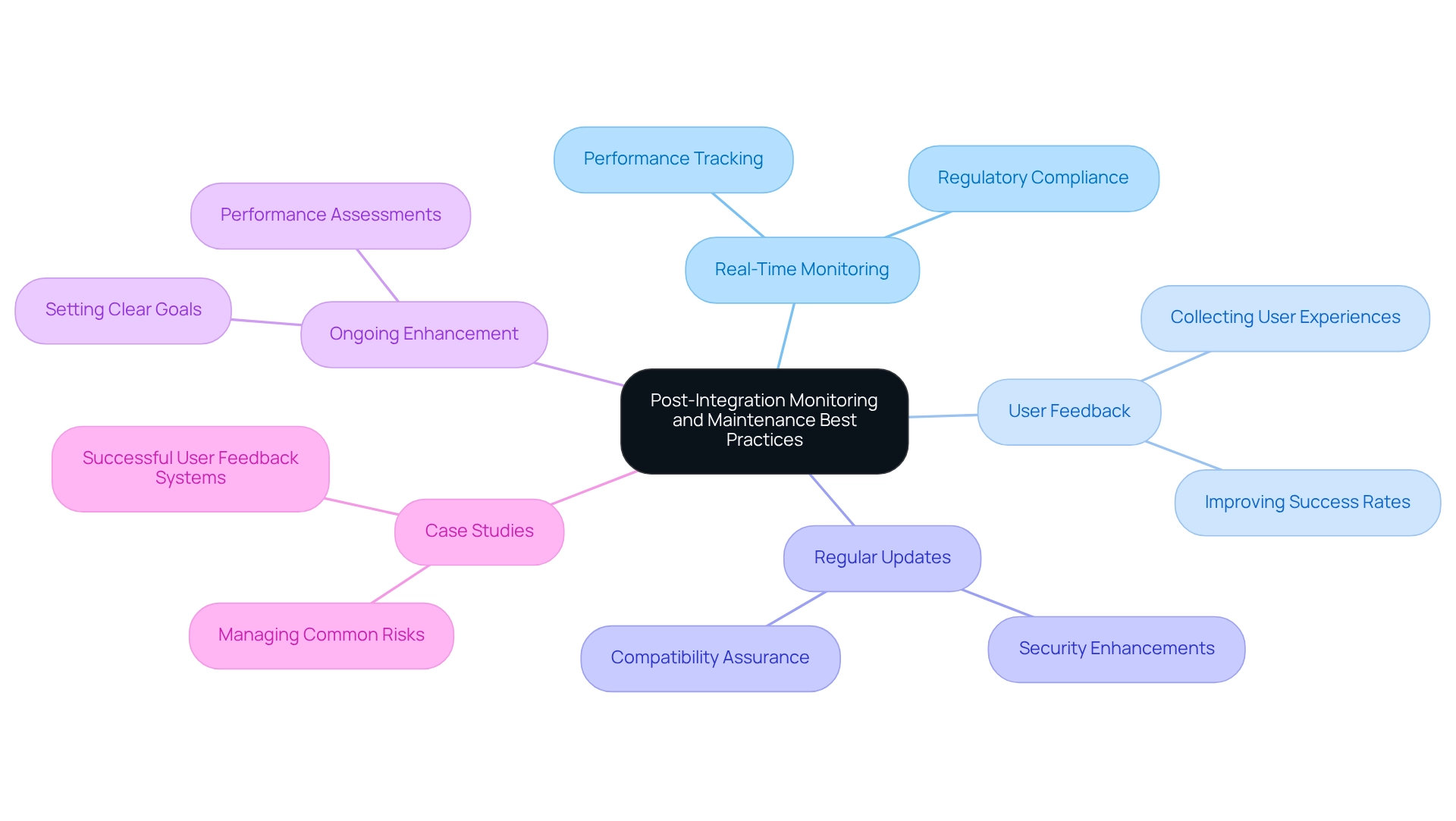
Conclusion
Legacy systems are integral to the operational framework of numerous organizations, particularly in sectors like banking and healthcare, where compliance and security are of utmost importance. The integration of these systems with modern technologies presents not merely a challenge but a significant opportunity to enhance efficiency, reduce costs, and drive innovation. By grasping the complexities inherent in this integration process, organizations can adeptly navigate potential pitfalls and leverage their legacy systems to gain a competitive edge.
The integration of legacy systems is fraught with challenges such as data incompatibility, security risks, and resistance to change, necessitating strategic approaches and best practices. Implementing a phased integration strategy, utilizing middleware solutions, and engaging stakeholders from the outset are critical steps that can dramatically increase the chances of success. Additionally, investing in training and continuous monitoring is essential to ensure that systems not only operate effectively post-integration but also evolve in response to changing business needs.
Organizations that embrace the integration of legacy systems position themselves to achieve heightened operational efficiency and agility. The advantages of improved data access, cost savings, and enhanced customer experiences highlight the strategic value of these initiatives. As businesses navigate their digital transformation journeys, leveraging dedicated platforms like Avato can simplify complex integration challenges and ensure that legacy systems contribute meaningfully to modern operations. Embracing this approach is vital for organizations striving to thrive in an increasingly competitive landscape.

